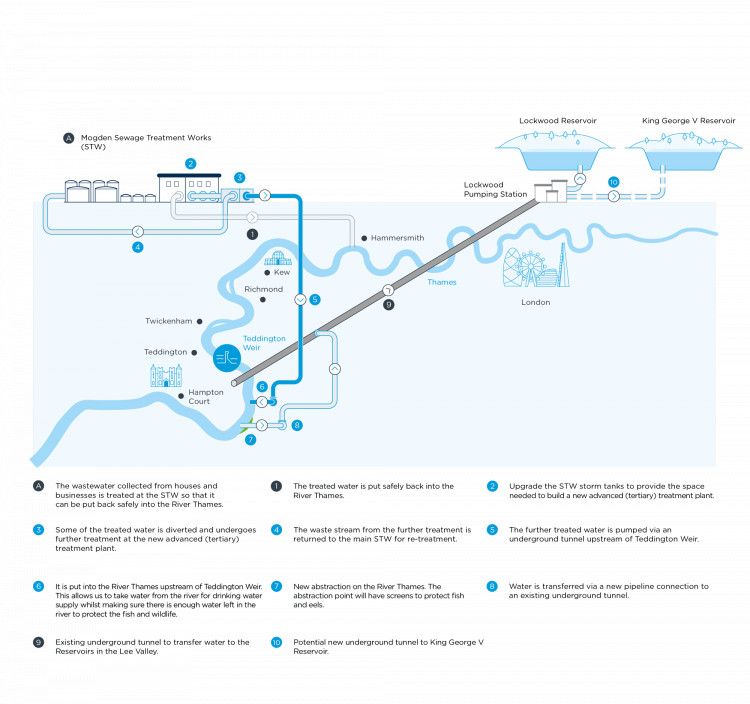Plan to drain water from Thames and replace it with treated effluent
By The Editor 11th Jan 2023
By The Editor 11th Jan 2023

A scheme to drain millions of litres of water a day from the Thames upstream of Teddington and then replace it with treated sewer effluent has been revealed.
It is among a number proposals from Thames Water to increase supplies needed to cope with a rising population and the risk of future droughts.
However, it has emerged they risk changing the chemical make-up and temperature of the Thames through Teddington, Twickenham and Richmond in a way that poses a threat to river life.
Few residents of the borough are aware of the schemes, while the details provided by Thames Water are sketchy and buried in a mountain of technical documents prepared by the company.
The company is to hold a public consultation at the Old Town Hall, Whittaker Avenue in Richmond on Monday, running from 2pm until 8pm. Public consultation on the proposals is due to close on March 21.

The main proposals affecting south west London involve:
* Thames Water will set up a new abstraction point between Teddington Weir and Hampton Court to take between 50 megalitres per day and 150 megalitres per day out of the river Thames. It is not clear what this would look like.
* This water will be transferred through a new pipeline to an existing tunnel that runs beneath London and then on to reservoirs in the Lee Valley to supply homes and businesses in the east of London and beyond.
* The water taken out of the river will be replaced by treated effluent which will pumped into the Thames further down the river towards Teddington Weir.
* This water will come from the Mogden Water Treatment Works in Isleworth, which is set to undergo a multi-million pound redevelopment and expansion.
* Getting the treated sewer water from Mogden to the Thames near the weir will involve building a new 15km pipeline.
Thames Water says these schemes, which could be completed by 2030, are the fastest and cheapest option to increase the amount of water needed to meet future demands.
Other proposals include efforts to cut down on leakage and the building of a new supersize reservoir south of Abingdon in Oxfordshire.
Thames Water justified the need for the schemes, saying: "Substantial water shortages face the whole of the South East of England.
"The extreme heat and lack of water we experienced this summer is a clear indication of climate emergency first-hand. The predicted regional water demand is set to increase, with the number of people living and working in London and the Thames Valley forecast to grow significantly.
"Every day, Thames Water currently supplies around 2.6 billion litres of water to customers across London and the Thames Valley. This is enough to fill 1,000 Olympic sized swimming pools.
"The company forecasts that it will need an extra 1 billion litres of water every day for customers by 2075 to accommodate climate change and population growth."
The company's schemes involve spending up to £13 billion between 2025 and 2050, which will have to be recouped from customers through bills.
It argued they are necessary 'to build in future resilience for the benefit of customers, their children, grandchildren and the environment'.
However, small print in documents prepared by the company reveal the schemes carry a cost to the environment and river life.
No information has been provided on what the site to abstract water from the Thames and the second one to pump treated effluent back in to the river will look like. These are sensitive locations in conservation areas.
In terms of river life, company documents say the proposals have the 'potential to cause … minor to moderate water temperature change' along the river between Teddington Weir and Walton. There would also be a change in salinity – salt levels – along the river through to Battersea.
Significantly, they identify 'changes to freshwater and estuarine fish community structure and migration patterns', plus an alteration of the life-cycle of macroinvertebrates, which are insects in their nymph and larval stages, such as snails, worms, crayfish, and clams.
They also state the proposals could also harm numbers of angiosperms, which are flowering plants, and phytoplankton, which is a key part of the river ecosystem.
Residents will have the opportunity to ask for further details at the Richmond event on Monday. Details can be found here - https://thames-wrmp.co.uk/hearing-your-views/our-events/
CHECK OUT OUR Jobs Section HERE!
twickenham vacancies updated hourly!
Click here to see more: twickenham jobs
Share:













